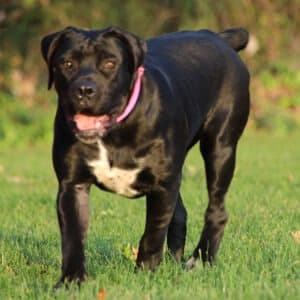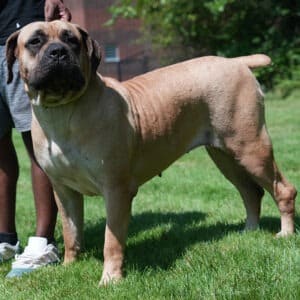Introduction

Welcome to a discussion that fascinates breed enthusiasts and casual admirers: the astonishing variety within the Boerboel breed. Originating from South Africa, the Boerboel has a rich history and a range of roles, making it a versatile and much-loved breed. Yet, those who delve deeper into the world of Boerboels soon realize that this is not a monolithic breed. Instead, there are notable variations, leading many to ask the compelling question, “Why are there so many types of Boerboels?”
Understanding the variations within the Boerboel breed is crucial for enthusiasts. It informs breeding choices, clarifies the types of work the dogs can perform, and deepens the appreciation of this unique breed. In this blog post, we will explore the historical roots of the Boerboel, examine the geographical factors contributing to its diversity, and discuss how different types of Boerboels fulfill specialized roles in work teams.
Historical Background: Function Over Form – The Origin Story
The rich and captivating tale of the Boerboel breed is deeply intertwined with the history of South Africa’s early settlers and agricultural communities. In a land characterized by its unforgiving terrain, unpredictable weather patterns, and an array of wildlife that could threaten humans and livestock, the need for a reliable and robust farm dog wasn’t just a nice-to-have but an essential factor for survival.
The approach to breeding these formidable dogs was pragmatic, focusing on the creature’s capabilities rather than its aesthetics. Unlike many other breeds where beauty or pedigree might be prioritized, South African farmers aka BOERS had a practical perspective. Their selection criteria for breeding were straightforward: the dogs needed to be hardworking, alert, healthy, and protective, characteristics that are indispensable for a life centered around farming in challenging conditions.
Scientifically, this method of selective breeding for traits rather than looks is known as “directional selection,” where specific characteristics become more common in a population because they offer some form of evolutionary advantage. Over generations, this approach has ensured that the Boerboel breed maintained a high level of functional efficacy. In essence, each succeeding age of Boerboels was as resilient and effective, if not more so, than their predecessors.

Unique Characteristics: A Synergistic Blend of Heritage and Adaptability
When you delve into the rich tapestry of the Boerboel’s genetic makeup, you explore a story of adaptability and survival. This breed didn’t evolve in a vacuum. It was the result of meticulous crossbreeding with various other breeds that the settlers and local populations introduced into the region. From robust European species like the Mastiff, known for their unparalleled strength, to indigenous African dogs that brought agility and endurance to the table, each crossbreeding event seemed to bestow the Boerboel with attributes making them increasingly adept at thriving in South Africa’s challenging environments.
The science of genetics tells us that genetic diversity can lead to hybrid vigor, technically known as “heterosis,” where the best traits from diverse gene pools are more likely to dominate. This scientific principle manifests practically in Boerboels as they display a versatile range of qualities such as muscularity, agility, keen instincts, and adaptable temperament. These traits have been naturally selected to help them face the daunting tasks and perils of their harsh native environment.
Rarity and Recognition: The Unwavering Focus on Purpose-Driven Evolution
While the Boerboel is beginning to find its way into the limelight, especially in specialized dog breeding circles and recognized kennel clubs, it’s crucial to remember that the spotlight is not what shaped this breed. Its evolution has been carved out by purpose and necessity, making it a breed that starkly contrasts those bred primarily for showmanship or companionship.
Today, breed enthusiasts and responsible breeders adhere to this foundational principle of prioritizing function over form. This approach preserves and celebrates the Boerboel’s origins as a functional, working breed. This steadfast commitment to practicality stands as a testament to the breed’s remarkable journey from being the indispensable farm dog of early South African settlers to gaining international recognition.
The increasing rarity of the Boerboel outside its native South Africa further emphasizes the importance of understanding its utilitarian roots. Genetic studies in animal breeding have shown that maintaining a focus on function can be vital for the long-term health of the breed, steering it clear of the many hereditary issues that can plague more inbred populations.
As we delve deeper into understanding Boerboel’s various subtypes, you’ll realize that its diversity is not a mere accident or an outcome of unfocused breeding. Instead, it’s a glowing tribute to its irreplaceable role in the communities it has served, shaped by evolutionary pressures that prioritized survival and functionality.
By understanding the Boerboel’s purpose-driven evolution and the functional imperatives that have historically guided its breeding, we set the stage for a nuanced discussion on the different types within this versatile breed. Stay tuned as we unravel why the Boerboel’s diversity is not just fascinating but also a vital aspect of its legacy and continued relevance.
Geographical Location and Work Requirements Necessitated Variety
Regional Variations in South Africa: Nature as the Master Breeder
South Africa’s diverse landscapes—ranging from arid plains and lush forests to jagged mountain ranges—have significantly influenced the Boerboel’s traits. The breed has been fine-tuned by the land it inhabits, much like Darwinian evolution crafting a creature impeccably suited for its environment. For example, the Boerboels from mountainous regions often display tremendous strength and stamina, essential for navigating steep terrains. On the other hand, those bred in more open plains are likely to be quicker and more agile, attributes necessary for covering large distances in less time.
The breed has also been shaped by the threats and challenges presented by wildlife, including predators like lions and leopards. The Boerboel had to be strong enough to deter or even confront such formidable adversaries while protecting its family and livestock. Human threats, like burglars or trespassers, also played a role in honing the Boerboel’s protective and alert instincts.
The Pack Mentality: Safety and Security in Numbers
One of the lesser-known but crucial aspects of the Boerboel’s work life is their tendency to work in packs. While the breed is often seen as an independent entity, its efficacy is amplified when working in coordination with other dogs. This pack mentality enhances the Boerboel’s role as a family companion focused on safety and security. In a pack, individual dogs can specialize in different tasks—some might be keen watchdogs, while others focus on physical deterrence or even engagement with threats. This collaboration provides a multi-layered security net for the family and property they are guarding, making it extremely difficult for intruders to breach.
Survival of the Fittest: Evolutionary Benefits of Breed Diversity
The multiple types within the Boerboel breed can be looked at through the lens of ‘Survival of the Fittest,’ a concept first put forth by Charles Darwin and later elaborated by scientists like Alfred Russel Wallace. A genetically diverse population often has a greater chance of survival, as it can adapt to a wider range of environmental challenges. According to scientific studies, a diverse gene pool is less susceptible to diseases and has a better chance of producing offspring with favorable traits. This genetic robustness is particularly important in a breed like the Boerboel, which has been exposed to various challenges, from hostile terrains to dangerous predators.
The breed’s functional diversity also enhances its survival prospects. For example, faster Boerboels are better at scouting and alerting the pack to danger, while stronger members are more effective at physical confrontations. This division of labor within the group ensures that each member’s strengths are utilized optimally, enhancing the pack’s overall survival rate.
The diversity within the Boerboel breed is not a random occurrence but a result of purposeful breeding, geographical necessity, and evolutionary advantage. Each type of Boerboel has evolved with traits that make it perfectly suited to the unique challenges presented by its environment and role. As we explore the topic further, it becomes increasingly clear that Boerboel’s diversity is a testament to its remarkable adaptability and its critical role in the lives of those it serves.
Geographical Location and the South African Boerboel: How Mother Nature Sculpted a Multi-Faceted Guardian
From the arid plains of the Karoo to the lush greenery of the Garden Route and up to the rugged terrains of the Drakensberg Mountains, South Africa’s incredibly diverse landscapes have been a master breeder for the South African Boerboel. Through a sort of natural selection reminiscent of Darwinian principles, this unique breed has been fine-tuned to adapt perfectly to its varying surroundings. Boerboels originating from mountainous areas often boast incredible strength and heightened stamina, essential traits for traversing steep, rocky lands. Meanwhile, the Boerboels bred in expansive, open plains display a different set of skills: they are typically faster and more agile, capable of covering large distances in shorter periods.
Moreover, the South African Boerboel has been naturally conditioned to face various challenges and threats from indigenous wildlife. Think predators of the big cat family—lions, leopards—and you’ll understand the strength and courage required to confront these formidable adversaries. Add to this the human threats like burglars or trespassers, and you’ll realize that the Boerboel has had to develop not just brawn but acute protective and alert instincts.
The South African Boerboel’s Pack Mentality: Collective Security Is the Best Security
The South African Boerboel may often be stereotyped as a lone guardian, but there’s power in numbers. One of the lesser-known yet significant aspects of this breed’s work ethic is its inclination toward pack mentality. While each Boerboel is indeed an effective, independent entity, they are amplified in efficacy when operating synergistically with a pack. Within these canine teams, individual South African Boerboels take on specialized roles: some serve as alert and keen watchdogs, while others specialize in physical deterrence or direct engagement with potential threats. This multi-layered approach to security makes it an uphill battle for any intruder trying to breach a property guarded by a pack of these robust dogs.
Survival of the Fittest: The South African Boerboel and the Science of Breed Diversity
When considering the various types within the South African Boerboel breed, one can’t help but invoke the concept of ‘Survival of the Fittest,’ a theory first introduced by Charles Darwin and later refined by other evolutionary scientists like Alfred Russel Wallace. Scientific research consistently shows that a genetically diverse population is more resilient and adaptable. Such populations have increased disease resistance and higher chances of producing offspring with beneficial traits.
For the South African Boerboel, this genetic variety is not just a theoretical advantage but a practical necessity. The breed faced many challenges ranging from negotiating hostile terrains to fending off dangerous wildlife. The genetic robustness conferred by diversity ensures that the Boerboel can adapt to these varying conditions. For instance, swifter Boerboels excel in reconnaissance roles, alerting the pack to approaching dangers, while their stronger counterparts may be more involved in physical confrontations with threats. This functional diversification enhances the breed’s overall survival rates, making each member’s contribution invaluable to the collective well-being.
The South African Boerboel’s diversity is far from coincidental. It is the result of meticulous breeding influenced by geographical necessity and evolutionary benefit. Every sub-type within this amazing breed brings its own set of skills and attributes, finely tuned to meet the unique challenges posed by its environment. As we delve deeper into understanding this remarkable breed, the South African Boerboel continues to stand as a testament to adaptability, resilience, and the indispensable role it has played in the lives of those it dutifully serves.

